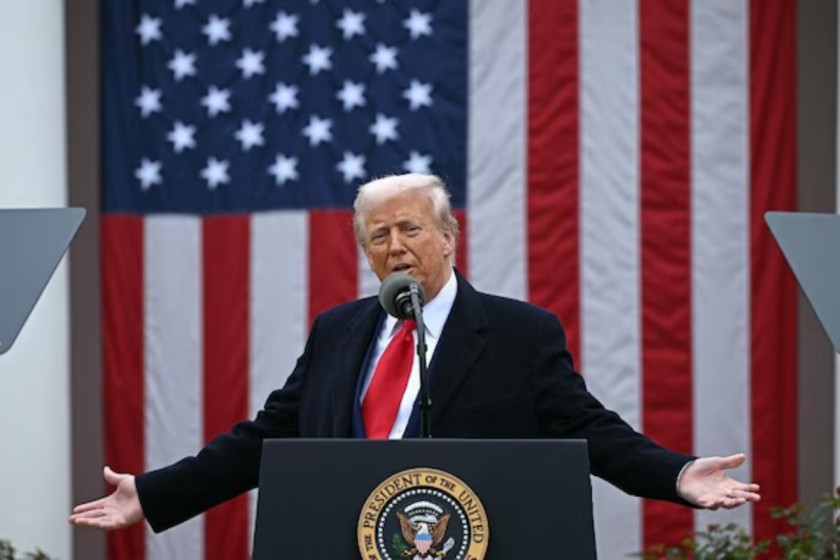- April 4, 2025
Trumping the tariff challenge

Liberation day came and went. The story of the day was in a single placard. The placard had the message that for 25 years the United States of America (US) had failed to deliver to the rest of the world.
But there is a paradigm shift in approach from decades of seeing other nations as cheap factories and low-cost food producers catering to US needs to one of self-reliance. The US suddenly seems to have realised that it gives more economic opportunities to the world than it gets. The equation is so lopsided that over decades, several nations have been running trade surpluses with the US, without even bothering to narrow it or provide more economic opportunity to it.
It was the sweeping election verdict in favour of the Republican Party with Donald Trump assuming office as the country’s President for the second time that set the stage for a drastic reset. Something needed to be done fast. There wasn’t too much time. The big awakening under President Donald Trump is the realisation that the US cannot just be a market for the world and needs to grab some of the world market. However, this realisation finally came when inflation was exported by the world into America post-Covid, making it politically very difficult and economically challenging. Clearly, a sense of urgency was at America’s door as the dollar was vulnerable and US deficits were ballooning.
So, Trump made this grand announcement of Liberation Day and went about negotiating bilateral treaties. No treaty has actually been signed yet and Trump simply went out and announced tariffs on every nation. Countries that don’t materially matter were slapped with a 10 per cent tariff, while those running huge surpluses with America while keeping their markets protected from American exports faced tariffs as high as 90 per cent.
The message is clear and loud. If you want to sell to us then, buy more from us. But what can America sell to the world?
We are now embarking on an economic path where other nations go about finding what they can buy from America. The clock won’t stop. Tariffs will hurt their respective local economies. They will clearly put governments across the world under intense local political pressure. While the easy way out for them would be to blame America, this approach may not hold much credibility in the long term. Governments have to work to get back their lost exports to the US. The profit pools that came from exports to the US have to be salvaged from the tariff wreck very quickly. Else, we could see stress on the financial system of countries exporting to the USA.
The USA has clearly upped the ante in a very clinical manner. On the one hand, it put intense pressure on every nation exporting significantly to the USA by imposing steep tariffs. On the other, by showing no great sense of urgency to negotiate, it made the other nations desperate for closure.
If other nations reciprocate with brinkmanship, the USA could well just keep quiet and strike treaties with more pliant trade partners. One can therefore expect bilateral talks to speed up hereon, in the hope of striking quick deals to mitigate the damages due to tariffs. Nations would also want to strike speedy deals so that their companies could fill the gaps in several industries left behind by the slower negotiators.
But there is also the prospect of a muted response from many nations to the reciprocal tariffs. Countries could simply drop their tariffs and then see a reversal of the US tariffs but the room for manoeuvres, in such cases, would be restricted.
As an investor, this phase has created uncertainties at many levels. One, Indian firms are still unclear about how and how much of a hit their revenue and earnings could take. Most firms think that their adverse impact will be less than their competitors from other nations facing even more severe tariffs.
Then, there is the hope that a bilateral agreement will swiftly get redressed and will reverse the adversities. People seem to be living on the hope that the damage will get controlled through diplomacy and tariff changes. This explains why Indian equity markets did not see huge corrections post-the tariff announcement. Or it was simply dismissed as “already priced into valuations” that have corrected since September.
The real impact, however, will be determined by how much time is lost in negotiations. A slow process will create a crisis of confidence in stocks from those sectors with higher exports to the US. There is also the fear that this tariff mission will take a lot of manufacturing back to the USA from Asian countries. The new and real fear is what China, that is lurking to capture a larger share of world markets at any opportunity that arises, might do. Will China deliberately impose retaliatory tariffs on critical US exports to China, fuelling a face off?
Certainly, the tariffs have triggered a major crisis. The hope is that the crisis will blow over as diplomacy prevails over the differences and brings normalcy back. But that needs most nations and governments wanting to settle the issue rather than precipitate it further into a full blown crisis.
The coming weeks will be crucial to assess how the negotiations are moving and when resolution will happen. As the dust settles over time (over the next couple of quarters), investors will get clarity over sales and earnings growth for companies largely dependent on the US economy. Or even gauge if some companies turn the crisis into an opportunity.
In the near term, investors must keep a tight watch over one’s asset classes and the stocks invested in as answers to the questions raised above finally unfold. These aren’t easy times. Investing could not have become more complex.
Shyam Sekhar is chief ideator and founder, ithought PMS.
Views are personal and do not represent the stand of this publication.
